
Travelogue
Photos
Today
New Inn
Killconnell Friary
Weird Sheep
Clonmacnoise Churches
Clonmacnoise Castle
Doon Castle
Grand Canal
Clonony Castle
Canal Locks
Castle
Birr Castle
Rosse Telescope
Birr Demesne
Gloghkeating Castle
Drumnahane Castle
Clohaskin Castle
Modreeny Church
Ashley Park B&B
Travelogue, Day 17
Well, I got my hot shower today (after two days of frigid water, albeit forceful frigid water!) but the tradeoff was that I had to do it in a bathroom the size of a kitchen cabinet. It was the tiniest bathroom that I've ever seen (including airplane bathrooms!) It looks as if it was simply inserted into a standard sized closet - about 24" deep and maybe three feet wide. You couldn't stand at the tiny, tiny sink with the door shut, I think the edge of the sink touched the door when it was closed! It was the perfect bathroom to be sick in, though -- not that we were,but it would be perfect. You could sidle in to sit on the toilet and then rest your forearms on the side of the sink and hang your head into it with no problem at all.
But it was the tiny shower that nearly did me in. It was slightly less than two feet square, as far as I can tell, and I kept turning around and accidentally turning off the water or turning it to SCALDING hot or FREEZING cold.
The whole thing was just slightly bigger than a cabinet, Mark pointed out, but I think there was actually less maneuvering room, since nothing was built into the wall. I'm pretty sure the toilet was slightly smaller than normal, too. I know that everyone like en-suite bathrooms, but in this case, it might have been preferable to have a nearby bathroom that was normal-human instead of pixie size. Don't get me wrong - I appreciate the effort. It was just so astonishingly small that we were flummoxed.
The B&B was otherwise comfortable and friendly but nothing fabulous. A rather desultory breakfast with cold toast and limp bacon sent us on our way. The hot shower was nice, though. We dropped off postcards this morning, too -- I figure we'd better let someone at home know that we're having a good time!
A Friary by any other name
Our plan was to drive out to Clonmacnoise, the large monastery/church complex, but of course we got sidetracked by a few things, including a standalone and apparently abandoned gatehouse near Newinn. I managed to get a whole shoe-full of briars and stickers from walking about in the knee-high grass.
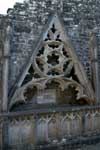 Kilconnel Friary is a lovely ruin, just in the middle of town and carpeted with green grass. We stopped to take pictures, but weren't hooliganish enough to actually climb the walls or anything. There was a stile to get inside the church, but there were still areas gated off.
Kilconnel Friary is a lovely ruin, just in the middle of town and carpeted with green grass. We stopped to take pictures, but weren't hooliganish enough to actually climb the walls or anything. There was a stile to get inside the church, but there were still areas gated off.
Most of the larger ruins of church and ecclesiastic buildings are abbeys -- Melrose Abbey, Jedburgh, Kilwinning and dozens of others. But the title of 'abbey' isn't really as descriptive as it might be. A friary is technically the habitation of friars (non-ordained monks), a monastery for monks, but it is common for christian monasteries to be called abbeys, priories, charterhouses, friaries, and preceptories. It seems to depend loosely on the title of the person in charge (abbot, prior, friar, preceptor, I guess), and may be remotely related to the size of the installation, but they seem to be roughly interchangeable, especially when they are in ruins.
From Wiki: A monastery may be an abbey (i.e., under the rule of an abbot), or a priory (under the rule of a prior), or conceivably a hermitage (the dwelling of a hermit). It may be a community of men (monks) or of women (nuns). A charterhouse is any monastery belonging to the Carthusian order. In Eastern Christianity a very small monastic community can be called a skete, and a very large or important monastery can be given the dignity of a lavra.
In any case, there are some specific, recognizable features of the ruins that further identify whether they are Carthusian, Cistercian, Benedictine, Dominicans, etc. (See Religious orders:) Cistercian monasteries were simple, with a low single tower. Carthusians had clusters of single cottages so that monks might live in absolute solitude; Benedictines had a specific cloister layout and rigid plan. After a while, it becomes possible to identify which sect built the church and other buildings, even if there really aren't many foundations remaining.
Like Monastsery-Land
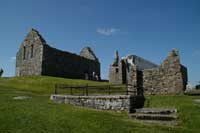 Anyone traveling in the UK in late April or May is used to seeing sheep everywhere. It's lambing season and herds of sheep are in nearly every pasture, roaming every roadside, and, sometimes, wandering in the road. It's always a bit risky to drive in the countryside - believe me, you'll be in more trouble if you hit a sheep than if you hit a car. They occasionally just lie down in the road to sleep, or arrange themselves in ranks on the curbside -- we saw a very dignified sheep (or goat? I have no idea, I'm a city girl) lounging about today. And yes, since I am a city girl unused to close encounters with any sort of animal, I took pictures.
Anyone traveling in the UK in late April or May is used to seeing sheep everywhere. It's lambing season and herds of sheep are in nearly every pasture, roaming every roadside, and, sometimes, wandering in the road. It's always a bit risky to drive in the countryside - believe me, you'll be in more trouble if you hit a sheep than if you hit a car. They occasionally just lie down in the road to sleep, or arrange themselves in ranks on the curbside -- we saw a very dignified sheep (or goat? I have no idea, I'm a city girl) lounging about today. And yes, since I am a city girl unused to close encounters with any sort of animal, I took pictures.
Clonmacnoise is an odd site. It's not a monastery, it's not a priory or convent, just a collection of seven churches and monuments, as if they build a new church each time the old one got a bit ratty. There doesn't appear to be any sort of plan for things, just random buildings. The fact that they would have all been standing at the same time is obvious, but how they related to each other is not. It's interesting to see the history of ecclesiastical architectural styles all in one place -- round headed arches in one church, ornate gothic decoration on another, gargoyle and face-bosses inside one, flower and leaf decorations in another. It's as if this small site is a test ground for new church design, or something. There's a little bit of everything all crammed into the low-walled churchyard, and even the remains of a little motte castle just outside the main gate.
Most of the churches here are very small -- there is no grand cathedral or multi-aisle churches here, just small chapels and cells. The guidebook assures me that they are actually churches and that services were held here. There's a very nice round tower, with it's stone capped roof intact, and some modern monuments mixed in with the rest.
One of the big draws of the site are the three celtic crosses. They are very important and quite interesting. Two of them are complete (most market crosses are missing bits, either just from age or from unfortunate accidents), the last one is just the shaft of the cross. They have moved the originals inside the exhibition space (a really cool hall made up of conical huts connected by a sinuous, very organic stone walkway. If you didn't know that the crosses outside in the churchyard were replicas, it would really be impossible to tell. They are very good copies.
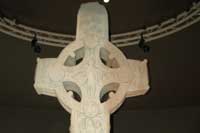 High crosses -- the very common celtic-style cross with the ring around the intersection of the cross' arms, appear all over Ireland (and, surprisingly, Scandinavian countries, too). Originally the ring was a structural addition (making stone arms a bit more stable), but they became part of the design very early and nearly all high crosses have the highly decorated ring. Most of the crosses are carved with intricate designs that can be "read" like a story -- often the genesis story or the fall of man or other common biblical parable. Many of these crosses were set up as "market crosses" - the location of the town's normal market district, or marking the main crossroads in town, etc. Quite a few remain in towns, but many were destroyed or damaged beyond repair. Those that were installed in churchyards (they are not technically headstones or grave markers, although they have ben used as such) tended to fare a little better.
High crosses -- the very common celtic-style cross with the ring around the intersection of the cross' arms, appear all over Ireland (and, surprisingly, Scandinavian countries, too). Originally the ring was a structural addition (making stone arms a bit more stable), but they became part of the design very early and nearly all high crosses have the highly decorated ring. Most of the crosses are carved with intricate designs that can be "read" like a story -- often the genesis story or the fall of man or other common biblical parable. Many of these crosses were set up as "market crosses" - the location of the town's normal market district, or marking the main crossroads in town, etc. Quite a few remain in towns, but many were destroyed or damaged beyond repair. Those that were installed in churchyards (they are not technically headstones or grave markers, although they have ben used as such) tended to fare a little better.
Canals and Locks
Off to find castles. We went through Doon and I scrambled up an embankment to get a picture of the remaining wall of their little tower house, and then wandered around the side roads trying to find the right intersection for things that were clearly marked on my map. For the most part, we hit every road that SHOULD have had a castle on it, but most didn't…it probably means we were a road off or took a turn we didn't mean to. In some cases we ended up driving in circles. I am telling Mark that this is so he really gets to know some of these small villages.
We ended up following a road near the Grand Canal that should have had a castle (but didn't, unless the grassy little hillock in the field was the last remnant of it, or this ruined house) and we discovered an aqueduct that was built so that the Grand Canal could cross another little river. That's weird (although not uncommon, I guess - canals tended to be straight-through affairs that crossed all manner of smaller waterways.)
The Grand Canal was built to connect Dublin with the River Shannon in the west, and was finished in the late 18th century. It was mostly used for commerce, although there were some passenger boats as well. It's obviously not used for anything but pleasure boating now, but it is definitely marvel of engineering to build all 80+ miles of this canal and the Royal Canal. Mark was absolutely fascinated by the set of manual locks that we found a bit upstream. The series of three locks lower/raise a boat about 25 feet and they are entirely hand-operated with long lever arms at ground level that can be pushed to and fro to close and open the gates. They are in good working order, it seems (although we were hesitant to start moving things, we have no idea how often they are actually used). Mark tried to pitch himself into the lower part of the lock a few times, all the while exclaiming how fun it would be to travel up and down the Canals in a small boat as a vacation. We saw a few shallow skiffs tied up near the banks, but no one else was around.
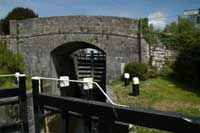 Once I finally dragged him away from his close inspection of the lock mechanisms, we drove on to Clonony and a quick stop to peer between the bars closing off the castle. The castle wall lies right along the road, and it looks as if someone is actively working on the buildings inside. Everything was locked up tight, though, and all we could do was get a few pictures form outside. I was hoping that whoever owned al the tools and ladders we could see would be around -- I'd love to ask just how you go about restoring one of these stone buildings, and what the intent was. No luck, though. I'm sure Mark is secretly relieved that I can't find anyone to talk restoration with -- or we'd be doing some real estate searches while on vacation!
Once I finally dragged him away from his close inspection of the lock mechanisms, we drove on to Clonony and a quick stop to peer between the bars closing off the castle. The castle wall lies right along the road, and it looks as if someone is actively working on the buildings inside. Everything was locked up tight, though, and all we could do was get a few pictures form outside. I was hoping that whoever owned al the tools and ladders we could see would be around -- I'd love to ask just how you go about restoring one of these stone buildings, and what the intent was. No luck, though. I'm sure Mark is secretly relieved that I can't find anyone to talk restoration with -- or we'd be doing some real estate searches while on vacation!
We snagged lunch in a gas station today. Don't laugh -- many (if not most) gas stations have very good delis or lunch counters that server sandwiches, hot pies, salads, and soups. We often don't want a big lunch, so a sausage roll or meat pie is just about enough for lunch. That, and cookies. I think we eat more cookies on vacation that we do for the entire rest of the year. We also discovered the Cadbury version of Ho-hos. Not too bad!
Edwardian Scientific Endeavors
Quite a few castles (most properly tower houses or bastles, really) are in private hands and are even used as family homes. Most of these are later mansions, not really "castles" in the true sense of the world (that is, they aren't really fortified or meant for war). Birr Castle is one of these, although the core of the "castle" is an actual tower house. The family still lives in the castle (the Parson's family has lived here for 400 years), so it's not possible to go inside, but the gardens have been opened to the public.
I'm not a huge garden fan, to be completely honest (and this is more of a wildlife park than any sort of planned garden), but Mark is instantly enamored of the giant Ross Telescope, one of the first in the world. It's enormous, and still has all the gears and cogs and machinery to manipulate it and keep the giant lens moving and focused on the skies. There is a very interesting museum here about the scientific discoveries and about the telescope itself.
The gardens here are enormous and mostly just wide open fields, but there is a walled knot garden and rose garden that has the tallest box hedges in the world. We did finally find someone to ask about the strange, smooth-barked trees that seem to be everywhere -- they're BEECH trees. We're hoping they grow in Colorado, as they are very attractive.
We're at about 20 u-turns today, as we try to navigate the side-roads and little country lanes (occasionally with the help of the GPS -- which, by the way is not terribly helpful). Mark keeps telling me that I'm "losing points" and won't win any prizes for best navigator. Phhbt. Even with specific grid locations in the GPS, we sometimes simply cannot FIND the spot we're pointing at. The network of roads is comprehensive and confusing to non-locals, is all I can say.
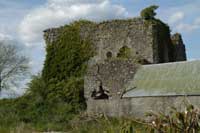 While trekking around (completely lost, I might add) looking for more castles we came across Clohaskin, which is a stumpy tower that is being used as part of a barn, in someone's farmyard. We waved merrily at the farmer, who watched us rather quizzically as we sidled around to get some pictures, but he disappeared before I could ask any questions. I can only imagine that all the people we run into while taking pictures of ruins think we're a bit crazy. They are so common place here that no one really notices them anymore, I think, and the idea that someone else might actually travel here to look at them has to be amusing. No one stared at us around Drumnahane or Gloghkeating, although the latter is at the end of someone's driveway, slowly moldering away into a pile of rubble. We found a local parish church in Modreeny that has one end that is crumbling away and is obviously the ruined walls of an earlier church. The church itself looks well-used, the extra crumbled bit (walled off, of course) is sort of ignored.
While trekking around (completely lost, I might add) looking for more castles we came across Clohaskin, which is a stumpy tower that is being used as part of a barn, in someone's farmyard. We waved merrily at the farmer, who watched us rather quizzically as we sidled around to get some pictures, but he disappeared before I could ask any questions. I can only imagine that all the people we run into while taking pictures of ruins think we're a bit crazy. They are so common place here that no one really notices them anymore, I think, and the idea that someone else might actually travel here to look at them has to be amusing. No one stared at us around Drumnahane or Gloghkeating, although the latter is at the end of someone's driveway, slowly moldering away into a pile of rubble. We found a local parish church in Modreeny that has one end that is crumbling away and is obviously the ruined walls of an earlier church. The church itself looks well-used, the extra crumbled bit (walled off, of course) is sort of ignored.
Mark says that I only like the "crumbly" stuff, and he's right. I like ruins covered in ivy far more than the restored and museum-quality castles that usually populate the tourist routes. Oh, well. There are plenty of either kind to see, even if they are hard to find sometimes.
Cooperative Driving
One of the strange things we saw today was a huge number of "dangerous bridge" signs. Lots of little bridges have a small sign attached -- they seem to precede a narrow bridge that either a) turns abruptly in the middle or b) is followed right on by a sharp turn. Most are single-lane bridges, and it's lucky they are short enough to easily see the people on the other end to do that silent pantomime to determine who does and who waits. There is a lot of 'cooperative driving' in Ireland -- there has to be!
We're staying in Nenagh today, so we popped into the Half Door pub in town for dinner. I'm really liking pub food -- I'm probably getting my year's worth of fried food in one month, but it's pretty tasty. Most of the pub meals are pretty simple: roast beef, chicken with some sort of sauce, meat pies, fish and chips, stews or chilis, along with chips and bread. It's warm, filling, and quite a good accompaniment to a pint of Guinness. You're not going to fine five star cuisine in most pubs, but they are surprisingly good. Once again, we're very early, but it always gives us a chance to talk to the bartender/owner, which is always fun. We get a lot of good tips of things to see and places to go from the staff in pubs.
We're doing enough during the day that we're falling into bed early and sleeping like logs. I'm still surprised that Mark doesn't snore when we're not at home. He claims it's from his time in the Army, but I’m not sure I'm buying that. It might just be that I fall into such a deep sleep that I don't hear him anymore. See? I told you that our vacations are exhausting!